Launch Meeting of IMF World Economic Outlook 2016
2016-10-12 IMI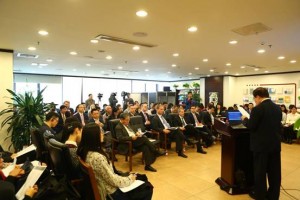 Mr. Wei gave a welcome speech in which he gave a brief overview of China’s urbanization and the OBOR Initiative. He confirmed the urgency in China to pursue an economic transformation, and also confirmed China’s headroom for further growth. He pointed out that China should maintain a steady restructuring process, continue pressing ahead with reform, facilitate policy communication and minimize the spillover effects. Also, he suggested that the spillover effect is not the main culprit in the current global economic slowdown. To pin down the causes behind, an overall analysis and more comprehensive perspectives are needed.
Mr. Wei gave a welcome speech in which he gave a brief overview of China’s urbanization and the OBOR Initiative. He confirmed the urgency in China to pursue an economic transformation, and also confirmed China’s headroom for further growth. He pointed out that China should maintain a steady restructuring process, continue pressing ahead with reform, facilitate policy communication and minimize the spillover effects. Also, he suggested that the spillover effect is not the main culprit in the current global economic slowdown. To pin down the causes behind, an overall analysis and more comprehensive perspectives are needed.
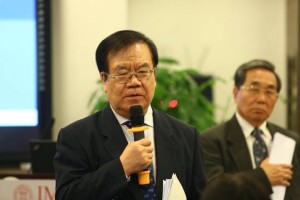 Mr. Alfred Schipke gave a brief overview of global outlook and recent developments in China. He claimed that this conference was the first meeting of world economic outlook after RMB’s inclusion into SDR, and therefore, was of profound significance. According to him, in terms of the world economy, main changes in recent months are as follows: growth performance in emerging markets (EMs)is improving; the financial market sentiment toward EMs has become more upbeat; commodity prices are firmed and capital flows have picked up. Despite of the positive signs, he further pointed out, the world remains to be heterogeneous, considering that advanced economies (AEs) continue to differ significantly in extent of post-crisis repair, and that some of the emerging market and developing economies (EMDEs) still face challenging conditions. He believes that the downside risks are mainly from protectionism, stagnation in AEs, China’s transition and financial volatilities in EMs. He suggested that countries should continue a three-pronged approach, namely, accommodative currency policy, fiscal support and structural reform; in addition, stabilize the financial market and expand multilateral cooperation. In terms of China’s slowdown and restructuring initiative, he pointed out that despite of China’s less reliance on industry and investment in GDP and its fast-growing service and consumption, China’s economy is still vulnerable, as a result of its persistent dependence on credit. He suggested that Chinese government take targeted measures, which include solving the problem of corporate debt, stopping credit stimulus and accepting an economic slowdown, preventing and controlling financial risks, moving toward an effective and flexible exchange rate mechanism, promoting policy communication, and improving the transparency of data.
Mr. Alfred Schipke gave a brief overview of global outlook and recent developments in China. He claimed that this conference was the first meeting of world economic outlook after RMB’s inclusion into SDR, and therefore, was of profound significance. According to him, in terms of the world economy, main changes in recent months are as follows: growth performance in emerging markets (EMs)is improving; the financial market sentiment toward EMs has become more upbeat; commodity prices are firmed and capital flows have picked up. Despite of the positive signs, he further pointed out, the world remains to be heterogeneous, considering that advanced economies (AEs) continue to differ significantly in extent of post-crisis repair, and that some of the emerging market and developing economies (EMDEs) still face challenging conditions. He believes that the downside risks are mainly from protectionism, stagnation in AEs, China’s transition and financial volatilities in EMs. He suggested that countries should continue a three-pronged approach, namely, accommodative currency policy, fiscal support and structural reform; in addition, stabilize the financial market and expand multilateral cooperation. In terms of China’s slowdown and restructuring initiative, he pointed out that despite of China’s less reliance on industry and investment in GDP and its fast-growing service and consumption, China’s economy is still vulnerable, as a result of its persistent dependence on credit. He suggested that Chinese government take targeted measures, which include solving the problem of corporate debt, stopping credit stimulus and accepting an economic slowdown, preventing and controlling financial risks, moving toward an effective and flexible exchange rate mechanism, promoting policy communication, and improving the transparency of data.
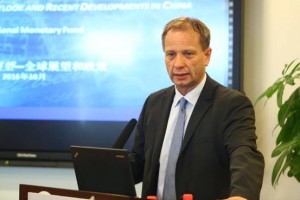 Mr. Esteban Vesperoni made a speech on spillover effects. He confirmed that china’s economic transformation will have positive effects on global economy in the long term but spillover effects are inevitable. After 2000, China is gaining pace in integrating into the international financial market, therefore, its transmission through trade, commodity consumption and asset prices will be amplified by financial markets. It is critical for China to take prudent measures in the transition period, to strengthen regulations as well as policy communication to minimize the spillover effects. Recipients economies should use buffers if available but need to plan for adjustment given lower demand. He also pointed out that migration brings both challenges and opportunities. In the short term, a migration influx might stir social tensions in recipient countries, but in a longer view, the increase of labor force with medium-to-high skills will supplement the local labors and improve the labor market as a whole by alleviating the aging pressure and boosting the economy. Therefore, it is critical for recipient countries to have an inclusive and integrated labor market, and provide guarantee to migrants and refugees. At last, he stressed that, given unstoppable trends of trade globalization and integration of labor market, protectionism must be avoided.
Mr. Esteban Vesperoni made a speech on spillover effects. He confirmed that china’s economic transformation will have positive effects on global economy in the long term but spillover effects are inevitable. After 2000, China is gaining pace in integrating into the international financial market, therefore, its transmission through trade, commodity consumption and asset prices will be amplified by financial markets. It is critical for China to take prudent measures in the transition period, to strengthen regulations as well as policy communication to minimize the spillover effects. Recipients economies should use buffers if available but need to plan for adjustment given lower demand. He also pointed out that migration brings both challenges and opportunities. In the short term, a migration influx might stir social tensions in recipient countries, but in a longer view, the increase of labor force with medium-to-high skills will supplement the local labors and improve the labor market as a whole by alleviating the aging pressure and boosting the economy. Therefore, it is critical for recipient countries to have an inclusive and integrated labor market, and provide guarantee to migrants and refugees. At last, he stressed that, given unstoppable trends of trade globalization and integration of labor market, protectionism must be avoided.
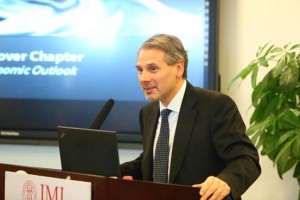 Mr. Marcos Poplawski-Ribeiro gave a speech on what’s behind the slowdown of global trade. Evidenced by statistics, he claimed that the trade slowdown is widespread across countries. And service trade is more resilient than goods trade; among goods, capital goods slowed down the most. As shown by the empirical models, on a global basis, import growth is consistently lower than predicted in the post 2012 period, for which the weakness in domestic absorption is mainly to blame. For EMDEs in particular, the slowdown is also a result of an increase in trade costs. Other factors weighing on trade growth include the rise of protectionism and non-tariff barriers. He concluded that slow global trade will likely persist in the medium term as long as global activity and investment remain weak; even when activity gathers momentum, trade is unlikely to return to the growth rates seen before the financial crisis. Policy makers should adopt growth-friendly measures, give more incentive to investment, revitalize free trade, avert protectionism, keep costs under control and facilitate trade integration.
Mr. Marcos Poplawski-Ribeiro gave a speech on what’s behind the slowdown of global trade. Evidenced by statistics, he claimed that the trade slowdown is widespread across countries. And service trade is more resilient than goods trade; among goods, capital goods slowed down the most. As shown by the empirical models, on a global basis, import growth is consistently lower than predicted in the post 2012 period, for which the weakness in domestic absorption is mainly to blame. For EMDEs in particular, the slowdown is also a result of an increase in trade costs. Other factors weighing on trade growth include the rise of protectionism and non-tariff barriers. He concluded that slow global trade will likely persist in the medium term as long as global activity and investment remain weak; even when activity gathers momentum, trade is unlikely to return to the growth rates seen before the financial crisis. Policy makers should adopt growth-friendly measures, give more incentive to investment, revitalize free trade, avert protectionism, keep costs under control and facilitate trade integration.
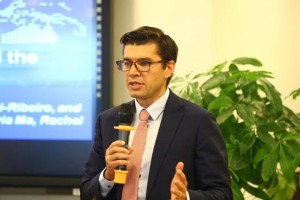 Mr. Lian Weicheng’s speech was themed on the global disinflation in an era of constrained monetary policy. He gave an in-depth analysis on the distribution, drivers and risks of this recent decline in inflation. He found that the disinflation is widespread and is across countries, measures, and sectors, with tradable goods’ disinflation larger than that in services. Drivers of recent disinflation include sluggish demand, weaker import prices and manufacturing over-capacity in major economies which puts downward pressure on global prices of tradable goods. Persistent disinflation will bring risks to global market. AEs are less sensitive to inflation than EMEs. In countries with constrained monetary policy, the degree of anchoring of inflation expectations has recently weakened, therefore, credibility of monetary policy risks being eroded. He pointed out that since AEs have run out of its monetary tools, the need for fiscal support to growth and demand-side structure reform are more urgent than ever to prevent risks of chronically undershooting targets. Meanwhile, policy makers should adopt a comprehensive and coordinated approach to tackle the problems of weak demand and over capacity across large economies.
Mr. Lian Weicheng’s speech was themed on the global disinflation in an era of constrained monetary policy. He gave an in-depth analysis on the distribution, drivers and risks of this recent decline in inflation. He found that the disinflation is widespread and is across countries, measures, and sectors, with tradable goods’ disinflation larger than that in services. Drivers of recent disinflation include sluggish demand, weaker import prices and manufacturing over-capacity in major economies which puts downward pressure on global prices of tradable goods. Persistent disinflation will bring risks to global market. AEs are less sensitive to inflation than EMEs. In countries with constrained monetary policy, the degree of anchoring of inflation expectations has recently weakened, therefore, credibility of monetary policy risks being eroded. He pointed out that since AEs have run out of its monetary tools, the need for fiscal support to growth and demand-side structure reform are more urgent than ever to prevent risks of chronically undershooting targets. Meanwhile, policy makers should adopt a comprehensive and coordinated approach to tackle the problems of weak demand and over capacity across large economies.
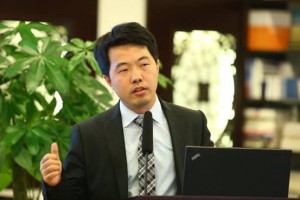 The forum is followed by a Q&A session centered on China’s labor market, international free trade, exchange rate reform and other issues.
The forum is followed by a Q&A session centered on China’s labor market, international free trade, exchange rate reform and other issues.
